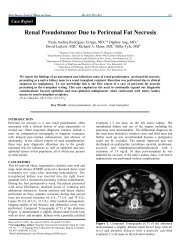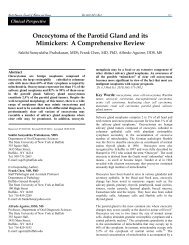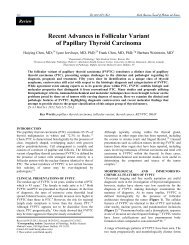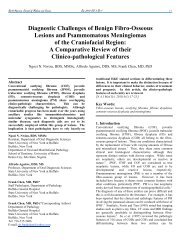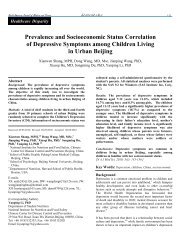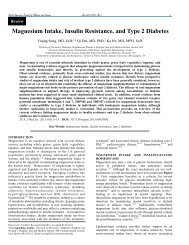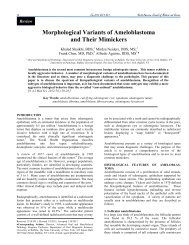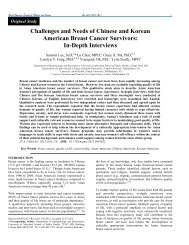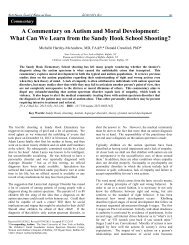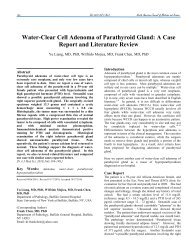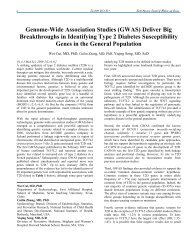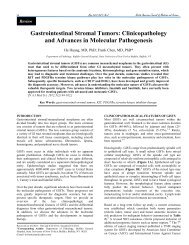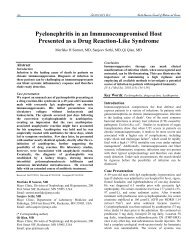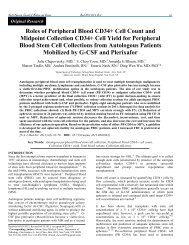Global Epidemiology of Hepatitis B Virus (HBV) Infection
Global Epidemiology of Hepatitis B Virus (HBV) Infection
Global Epidemiology of Hepatitis B Virus (HBV) Infection
- No tags were found...
Create successful ePaper yourself
Turn your PDF publications into a flip-book with our unique Google optimized e-Paper software.
North American Journal <strong>of</strong> Medicine and Science Jan 2010 Vol 4 No.1 11women. 38 More recent studies, published in 2009 and 2010,show that prevalence rates have decreased in Egypt. A study<strong>of</strong> 616 barbers and their clients in a mixed urban and ruralsetting revealed a HBsAg prevalence rate <strong>of</strong> 4.2%. 39 Anotherstudy screened almost 56,000 asymptomatic blood donors,mostly from rural areas, and found the seroprevalence rate tobe only 1.3%. 40In a 2002 Pakistani study, the prevalence <strong>of</strong> <strong>HBV</strong> infectionwas found to be 3.3% from a sample <strong>of</strong> over 100,000voluntary blood donors. 41 In 2005, a study in the obstetricand gynecological population in Pakistan found a 4.6%prevalence in women <strong>of</strong> childbearing age. 42 A recentpopulation-based study in Iran showed a prevalence rate <strong>of</strong>hepatitis B surface antigen to be 2.6% in 6,583 randomlysubjected subjects from three provinces in Iran, namelyTehran, Golestan, and Hormozgan. 43Throughout the Eastern Mediterranean region, transmissionoccurs through childhood horizontal and adult horizontalroutes, and less commonly, vertical routes. Risk factorsassociated with infection include residence in a rural area,overcrowding, poor sanitary conditions, parenteral drug use,exposure to blood products, medical procedures, ear piercingand scarification. 38<strong>HBV</strong> in AfricaThis region covers all <strong>of</strong> Sub-Saharan Africa and Algeria.Africa has the second largest number <strong>of</strong> chronic carriers afterAsia and is considered a region <strong>of</strong> high endemicity. Theexact burden <strong>of</strong> hepatitis B in Africa is difficult to assess dueto inaccurate records and under-reporting, but between 70and 95% <strong>of</strong> the adult population show evidence <strong>of</strong> pastexposure to <strong>HBV</strong> infection and the estimated HBsAgseroprevalence ranges from 6-20%. 44,45Western Africa has the highest rates <strong>of</strong> endemicity withinAfrica with as many as 95% <strong>of</strong> the adult populationdisplaying markers <strong>of</strong> past <strong>HBV</strong> exposure. The prevalencerate in Gambia and Senegal are about 15%, with age-specificprevalence as high as 20% in 10- to 20-year olds. Notsurprisingly, this region also has one <strong>of</strong> the world’s highestrates <strong>of</strong> HCC. In Gambia, HCC is the most common canceramong men and the second most common cancer amongwomen. 6,46,47Different areas <strong>of</strong> Africa have varying prevalence rates.Some <strong>of</strong> the variability lies in the size <strong>of</strong> the study and thegeographical location in Africa, but it appears that in general,higher prevalence rates are encountered in rural areascompared to urban areas. A study <strong>of</strong> chronic <strong>HBV</strong> infectionamong 2364 urban black children in Soweto, Johannesberg,South Africa showed an HBsAg positivity <strong>of</strong> 1%. This lowcarrier rate applied equally to children from the lowest andthe highest socioeconomic groups in Soweto. This is incontrast to the established prevalence rate <strong>of</strong> 15% in ruralblack children in southern Africa. This significant differencein <strong>HBV</strong> carrier rate could be attributed to poor hygiene andgreater chances <strong>of</strong> <strong>HBV</strong> transmission through skin abrasions,insect bites, use <strong>of</strong> contaminated needles, tribal scarificationand ear piercing using contaminated equipment. 48,49In contrast to Asia where perinatal transmission is mostcommon, horizontal transmission in childhood is thought tobe the predominant mode <strong>of</strong> infection in Africa. Forexample, in Western Africa, <strong>HBV</strong> infection is uncommon innewborns, but then infection rates rise with age. By the age<strong>of</strong> 2 years, 30% <strong>of</strong> West African children have been infectedwith <strong>HBV</strong> and 15% have developed persistent infection. Bythe age <strong>of</strong> 10 years, 90% <strong>of</strong> children have become infectedand 20% have become chronic carriers. A major reason forthe relatively low rate <strong>of</strong> perinatal transmission is the lowerprevalence <strong>of</strong> HBeAg positivity, which is considered amarker <strong>of</strong> active viral replication. A lower prevalence <strong>of</strong>HBeAg positivity has been observed in mothers from Sub-Saharan Africa compared with mothers in Asia, suggesting alower potential for vertical transmission. 45<strong>HBV</strong> in South-East AsiaThis region is comprised <strong>of</strong> Bangladesh, Bhutan, NorthKorea, India, Indonesia, Maldives, Myanmar, Nepal, SriLanka, Thailand and Timor-Leste. It is considered to be <strong>of</strong>intermediate to high endemicity with prevalence ratesranging from 1-10%. 28In India, the national prevalence rate has been estimated to be4% with approximately 36 million carriers overall. 50 Anextensive review by the Indian National Association for theStudy <strong>of</strong> Liver Diseases estimated the average nationalprevalence rate to be 4.7%. 51 However, as with othercountries that cover a large geographic area, the prevalence<strong>of</strong> hepatitis B is variable throughout the country with agradient <strong>of</strong> generally increasing prevalence from north tosouth. The lowest prevalence is 2.3% in a large cohort <strong>of</strong>20,000 blood donors in northern India. 52 The highestreported rate is 5.7% in a community based study in almost2000 people from southern India. 53 Transmission is mostlythrough childhood horizontal spread due to sub-optimalhygiene and crowded living conditions.The impact <strong>of</strong> universal vaccination can clearly be observedin Thailand. Prior to universal vaccination, there was aprevalence rate <strong>of</strong> 8.2% in blood donors in Thailand. 54 In2004, twelve years after the initiation <strong>of</strong> universalvaccination, the prevalence <strong>of</strong> HBsAg carriers decreased to4% among the 6213 subjects studied. 55 This trend was alsowitnessed in a hepatitis B screening program <strong>of</strong> healthy Thaiworkers going abroad. In 1996, the annual prevalence inalmost 25,000 workers was 6.1%; by 2001, the prevalencehad decreased to 2.8%. 56<strong>HBV</strong> in the Western PacificThe Western Pacific region includes: Australia, BruneiDarussalam, Cambodia, China, Cook Islands, Fiji, Japan,



